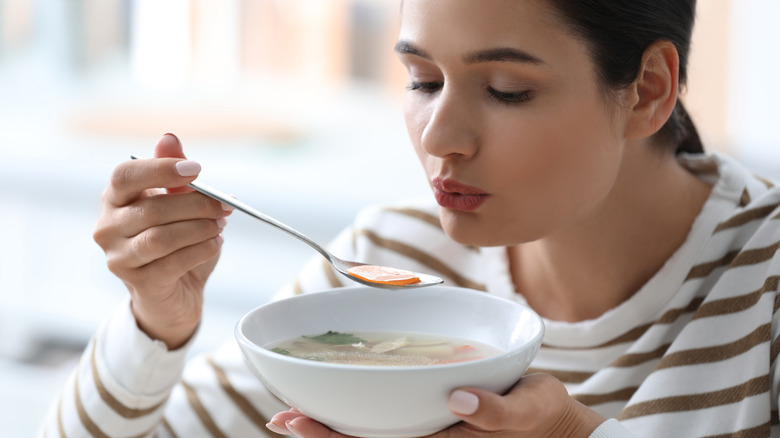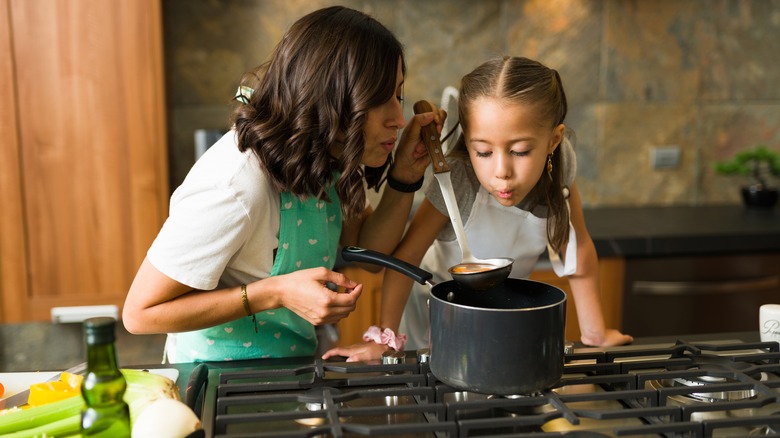The Science Behind Blowing On Hot Food
Some people are content eating leftover food straight out of the refrigerator. Others may prefer a lukewarm meal. Then there are daredevils who enjoy food that is so spicy, they may even experience physical pain. For example, Jakarta's "death noodles" are so fire, they apparently caused someone testing the noodles to lose their hearing for a few minutes (per Vice). Despite these differences, the majority of people have likely blown on a hot meal that arrives in front of them to cool it off.
It makes sense that most people blow on a bowl of hot soup or cup of tea to avoid getting burnt. According to The University of Washington, most of the coffee you order is much hotter than temperatures that may cause even a mild burn. Dr. Sam Mandell says that any food or drinks that are more than 110 degrees Fahrenheit can lead to "a superficial burn," while meals or beverages over 160 degrees Fahrenheit will quickly lead to an actual burn. The National Coffee Association suggests that coffee should be made in water that is at least 195 to 205 degrees Fahrenheit, therefore, if you drink your cup of Joe seconds after it's made, you're likely to get burnt.
You can wait for your plate of chili or cappuccino to cool off. But will blowing on a hot meal or beverage actually make it colder, or are you just fooling yourself?
What happens when you blow on hot food?
Your breath is close to the average body temperature, which is 98.6 degrees Fahrenheit (per ThoughtCo.). But hot food is higher than this temperature. When you blow on your food, the colder air from your body temperature goes to where the hot air was previously, which is known as "convection." Just as there are creative ways to cool down spicy food, when you blow on hot food, you are making it colder.
Science may help you better understand what factors cause your food or drink to cool off more quickly so that you can avoid burning your mouth. When there is a large contrast between "the energy of the molecules," such as holding a hot cup of green tea on a cold day or a snow cone on a summer day, the temperature change will occur more rapidly than if there is a minor contrast — think warm pasta on a warm dish or "a refrigerated salad at room temperature."
According to a separate article from ThoughtCo., thermal energy is "heat energy" that illustrates a contrast in temperature "between two systems." For example, human beings and a warm cup of coffee have thermal energy. This energy can be compared with "the [surrounding] environment." But in both cases, the changes happen fairly slowly. Blowing on hot food generally speeds up the process because you are making the contrast in energy between the food and its environment higher, letting the food become colder.
The effect of blowing on hot liquids
Interestingly, you're likely to have better luck getting a hot beverage to become colder more rapidly than your food due to a process known as "evaporative cooling" (per Mental Floss). If your food or drink is more of a liquid, like tea or soup, you can use evaporative cooling to shift "the water vapor away from the surface of the heated element," which really means you're blowing the steam away, cooling off the hot item. Evaporative cooling works better than blowing on a dish that does not have a lot of moisture, so you're likely to be more successful in blowing on hot liquids.
The science says it all: Blowing on a piping hot casserole that just came straight out of the oven or a cup of hot black tea will save you from screaming "ouch" because you've burnt your mouth. If you forget to blow on your food or drink, Everyday Health suggests you can always rely on an ice cube, milk, vitamin E, or oral pain relievers to alleviate the burn. But why not take action before that happens and let convection take care of you?


